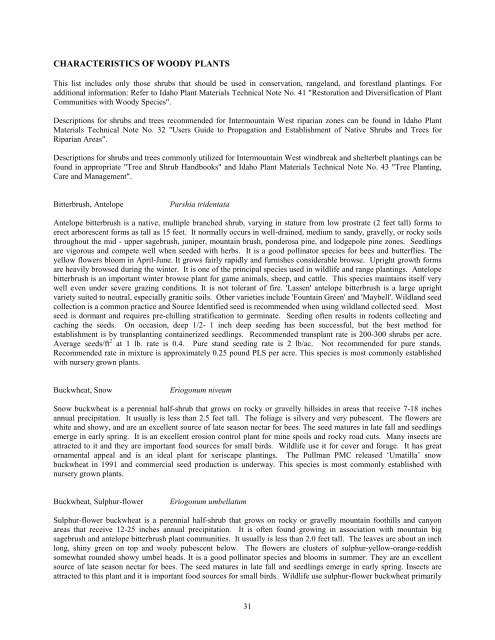Idaho Plant Materials Technical Note No. 24
Idaho Plant Materials Technical Note No. 24
Idaho Plant Materials Technical Note No. 24
Create successful ePaper yourself
Turn your PDF publications into a flip-book with our unique Google optimized e-Paper software.
CHARACTERISTICS OF WOODY PLANTS<br />
This list includes only those shrubs that should be used in conservation, rangeland, and forestland plantings. For<br />
additional information: Refer to <strong>Idaho</strong> <strong>Plant</strong> <strong>Materials</strong> <strong>Technical</strong> <strong><strong>No</strong>te</strong> <strong>No</strong>. 41 "Restoration and Diversification of <strong>Plant</strong><br />
Communities with Woody Species".<br />
Descriptions for shrubs and trees recommended for Intermountain West riparian zones can be found in <strong>Idaho</strong> <strong>Plant</strong><br />
<strong>Materials</strong> <strong>Technical</strong> <strong><strong>No</strong>te</strong> <strong>No</strong>. 32 "Users Guide to Propagation and Establishment of Native Shrubs and Trees for<br />
Riparian Areas".<br />
Descriptions for shrubs and trees commonly utilized for Intermountain West windbreak and shelterbelt plantings can be<br />
found in appropriate "Tree and Shrub Handbooks" and <strong>Idaho</strong> <strong>Plant</strong> <strong>Materials</strong> <strong>Technical</strong> <strong><strong>No</strong>te</strong> <strong>No</strong>. 43 "Tree <strong>Plant</strong>ing,<br />
Care and Management".<br />
Bitterbrush, Antelope<br />
Purshia tridentata<br />
Antelope bitterbrush is a native, multiple branched shrub, varying in stature from low prostrate (2 feet tall) forms to<br />
erect arborescent forms as tall as 15 feet. It normally occurs in well-drained, medium to sandy, gravelly, or rocky soils<br />
throughout the mid - upper sagebrush, juniper, mountain brush, ponderosa pine, and lodgepole pine zones. Seedlings<br />
are vigorous and compete well when seeded with herbs. It is a good pollinator species for bees and butterflies. The<br />
yellow flowers bloom in April-June. It grows fairly rapidly and furnishes considerable browse. Upright growth forms<br />
are heavily browsed during the winter. It is one of the principal species used in wildlife and range plantings. Antelope<br />
bitterbrush is an important winter browse plant for game animals, sheep, and cattle. This species maintains itself very<br />
well even under severe grazing conditions. It is not tolerant of fire. 'Lassen' antelope bitterbrush is a large upright<br />
variety suited to neutral, especially granitic soils. Other varieties include 'Fountain Green' and 'Maybell'. Wildland seed<br />
collection is a common practice and Source Identified seed is recommended when using wildland collected seed. Most<br />
seed is dormant and requires pre-chilling stratification to germinate. Seeding often results in rodents collecting and<br />
caching the seeds. On occasion, deep 1/2- 1 inch deep seeding has been successful, but the best method for<br />
establishment is by transplanting containerized seedlings. Recommended transplant rate is 200-300 shrubs per acre.<br />
Average seeds/ft 2 at 1 lb. rate is 0.4. Pure stand seeding rate is 2 lb/ac. <strong>No</strong>t recommended for pure stands.<br />
Recommended rate in mixture is approximately 0.25 pound PLS per acre. This species is most commonly established<br />
with nursery grown plants.<br />
Buckwheat, Snow<br />
Eriogonum niveum<br />
Snow buckwheat is a perennial half-shrub that grows on rocky or gravelly hillsides in areas that receive 7-18 inches<br />
annual precipitation. It usually is less than 2.5 feet tall. The foliage is silvery and very pubescent. The flowers are<br />
white and showy, and are an excellent source of late season nectar for bees. The seed matures in late fall and seedlings<br />
emerge in early spring. It is an excellent erosion control plant for mine spoils and rocky road cuts. Many insects are<br />
attracted to it and they are important food sources for small birds. Wildlife use it for cover and forage. It has great<br />
ornamental appeal and is an ideal plant for xeriscape plantings. The Pullman PMC released ‘Umatilla’ snow<br />
buckwheat in 1991 and commercial seed production is underway. This species is most commonly established with<br />
nursery grown plants.<br />
Buckwheat, Sulphur-flower<br />
Eriogonum umbellatum<br />
Sulphur-flower buckwheat is a perennial half-shrub that grows on rocky or gravelly mountain foothills and canyon<br />
areas that receive 12-25 inches annual precipitation. It is often found growing in association with mountain big<br />
sagebrush and antelope bitterbrush plant communities. It usually is less than 2.0 feet tall. The leaves are about an inch<br />
long, shiny green on top and wooly pubescent below. The flowers are clusters of sulphur-yellow-orange-reddish<br />
somewhat rounded showy umbel heads. It is a good pollinator species and blooms in summer. They are an excellent<br />
source of late season nectar for bees. The seed matures in late fall and seedlings emerge in early spring. Insects are<br />
attracted to this plant and it is important food sources for small birds. Wildlife use sulphur-flower buckwheat primarily<br />
31
















